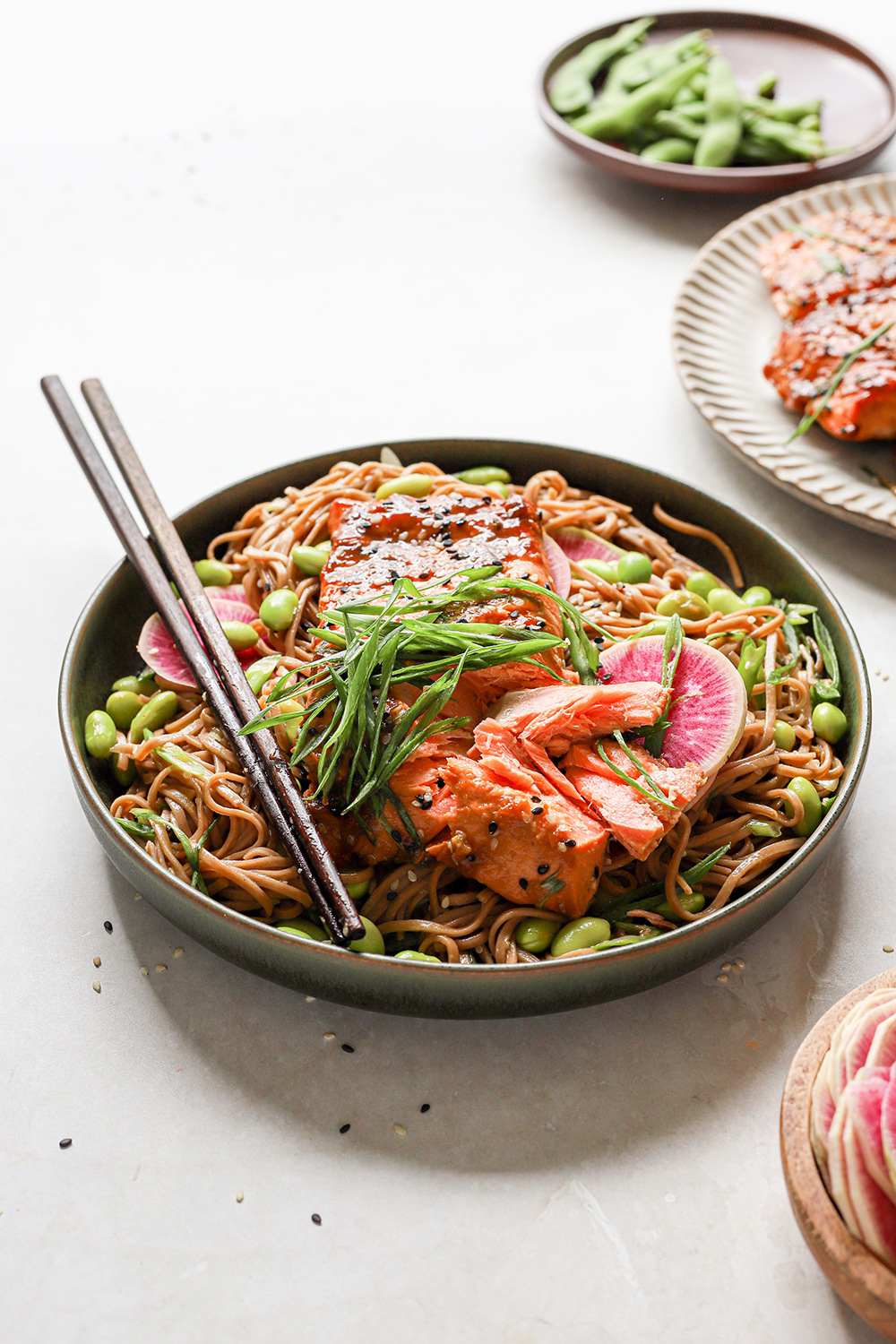This teriyaki salmon recipe is a delicious dish that comes together quickly, making it perfect for busy weeknights. It is packed with flavor from the salty soy sauce

and pungent and slightly spicy garlic and ginger. The salmon is quickly marinated in the teriyaki sauce before being seared to perfection. The teriyaki marinade is then cooked into a glaze before being tossed with the cooked soba noodles and fresh vegetables.
Things to love about this recipe
It is quick to make. This recipe comes together in about 40 minutes, making it perfect for midweek meals.
It is easily adapted to meet the needs of your family. Add more vegetables if you like, or make the recipe as is. If your family is gluten-free, this recipe is easily adapted.
Recipe variations
This recipe can be made with other types of salmon like sockeye, or king, or white fish such as lingcod, Pacific cod, or halibut. Just note that cooking time may need to be adjusted slightly depending on the thickness of the fish.

The options are endless when it comes to vegetable additions to this recipe. Prepare it as is, or add more of your favorites to make it a vegetable-packed meal. Consider adding snow peas, broccoli florets, sliced asparagus spears, sliced bok choy, sugar snap peas, or thinly sliced bell peppers.
The teriyaki salmon bowl can easily be altered to be gluten-free by keeping a few things are kept in mind. Use a gluten-free tamari or coconut aminos in place of the regular soy sauce, and swap in 100% buckwheat soba noodles for the regular soba noodles.
Equipment
Tweezers: If you cook fish often, it is a good idea to invest in a dedicated pair of fish tweezers. They make removing pin bones essentially effortless. Most of Wild for Salmon's fish is sold without the bones, but the coho comes with bones still in. It's always a good idea to double-check that the fish you have does not have any hiding bones. To do so, run your fingers in both directions across the top and sides of the fish and pull out any bones you find. This is especially important if you are planning on serving children.
Baking dish: Use a small shallow baking dish to marinate the salmon in the teriyaki sauce before cooking.
Large skillet: A large cast iron skillet is ideal for cooking fish because of its even heat retention. A 12-inch skillet is the best size for this recipe. It's large enough to leave space to sear the salmon and toss the noodles and vegetables in the sauce. Small mixing bowl: A small mixing bowl is used to make the marinade. Whisk: A whisk makes mixing the sauce a quick task. It is ideal for making sure there are no lumps of cornstarch, but a large fork or spoon could be used instead. Sharp chef's knife: A sharp knife is key when thinly slicing the radish and green onions, this task is quite difficult with a dull knife.
Ingredients

Wild for Salmon Coho salmon fillets: Coho salmon is a firm flesh fish and holds up well to the marinating and searing in this recipe.
Soy sauce: Soy sauce makes up the base of the sauce and is responsible for adding all of the salt to the recipe. If you prefer, low-sodium soy sauce, tamari, or coconut aminos could be used instead.
Brown sugar: Sugar helps give the teriyaki sauce its signature sweet flavor. Rice vinegar: Rice vinegar helps cut the salty-sweet flavor of the sauce. Cornstarch: Cornstarch is used to thicken the sauce and turn it into a glaze that easily coats the noodles and salmon.
Garlic: Use fresh garlic if you can, it has the best flavor and adds a lot of depth to the sauce.
Fresh ginger: Use a microplane grater to easily grate the fresh ginger. It is one of the signature flavors of Japanese cooking and brings a lot to the sauce.

Red pepper flakes: Red pepper flakes are optional, but they add some depth of flavor to the sauce without making it too spicy. If you like heat, add several pinches. Sesame oil: Sesame oil is a high-heat oil that is suitable for searing, and adds a subtle sesame flavor to the sauce as well. If you don't have it on hand, another neutral high-heat oil such as avocado oil could be used.
Soba noodles: Soba noodles are a Japanese noodle made primarily from buckwheat flour, with some regular wheat flour mixed in. They are whole-grain noodles loaded with fiber, vitamins, and minerals. Sometimes they are made with 100% buckwheat flour, though the blended ones are most common.
Edamame: Edamame is a soybean pod and can be found in the frozen vegetable section of your grocery store.
Watermelon radishes: Watermelon radish is a fun way to bring color and texture to your table. They are white and green on the outside, and vibrant shades of pink and red
on the inside just like a watermelon! If you can't find watermelon radishes, use another type of daikon radish or regular red radishes instead.
Green onions: Green onions or spring onions add a lot of flavor and a bit of fresh greens to the dish. They make an excellent garnish too, to do this simply slice them thinly on a very steep bias.
Sesame seeds: Sesame seeds add color and texture to the dish and are added at the end as a garnish. Use white, black, or a mixture of both.
[[ recipeID=recipe-8lhp2ojli, title=Teriyaki Salmon with Soba Noodles ]]
AUTHOR PROFILE

Marisa Kerkvliet of Lemon Thyme Kitchen is a freelance recipe developer and food photographer with a Master’s degree in Nutrition. She was raised on her family’s farm in Northwest Washington and her appreciation for good food developed at a very early age. She is passionate about creating recipes and beautiful imagery that highlight high-quality seasonal ingredients. Marisa loves all types of seafood, but her favorites are salmon and scallops!




